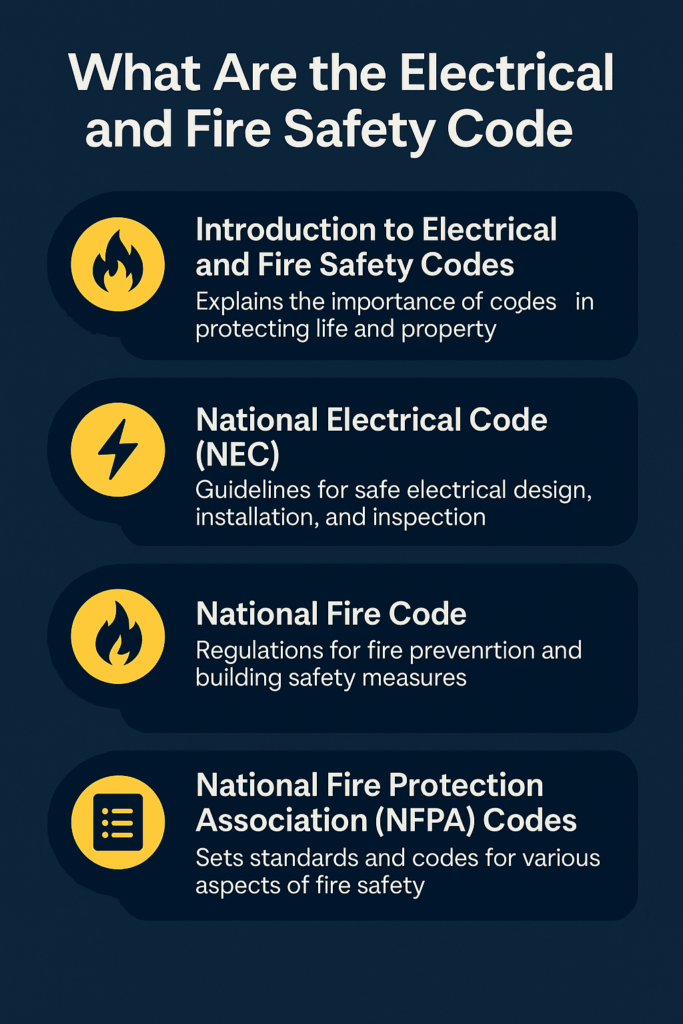Ensuring safety in any residential, commercial, or industrial property begins with understanding and complying with electrical and fire safety codes. These codes exist to safeguard lives, protect properties, and maintain public welfare by regulating installations, equipment use, and emergency preparedness. This guide will help you understand what the codes are, how to access them, and how to stay compliant—while highlighting unique fire safety resources available on fireextinguisher info.
Understanding the National Electrical Code (NEC)
The National Electrical Code (NEC), published by the National Fire Protection Association (NFPA), serves as the benchmark for safe electrical design, installation, and inspection to protect people and property from electrical hazards. It is updated every three years and widely adopted across the U.S.
The NEC covers everything from wiring methods and equipment installation to safety systems in residential and commercial buildings. It’s essential reading for electricians, contractors, and building managers.
Related Resource: Top Fire Extinguishers for Electrical Fires

Accessing the National Electrical Code Online
The full NEC can be accessed through the NFPA website. While some parts are behind a paywall, the NFPA offers limited access to the national electrical code online free of charge for viewing. This is a great starting point for anyone looking to familiarize themselves with electrical standards before hiring a certified professional.
Overview of the National Fire Code
The National Fire Code is a collection of fire safety standards developed by the NFPA. It encompasses various aspects such as fire prevention, emergency planning, sprinkler systems, fire alarms, and building construction materials.
These codes help reduce the risk of fire outbreaks and ensure safe evacuation during emergencies. Local jurisdictions may modify or expand upon these codes, making it essential to consult with your municipal fire department.
Helpful Guide: Different Classes of Fire and How to Extinguish Them
National Fire Protection Association (NFPA) Codes and Standards
The NFPA publishes over 300 codes and standards, making it the leading authority on fire and life safety. Among these, the most widely recognized include:
- NFPA 1: Fire Code
- NFPA 70: National Electrical Code
- NFPA 101: Life Safety Code
- NFPA 10: Standard for Portable Fire Extinguishers
Adopting these standards helps businesses stay compliant and protect their investments.
Key Fire Code Regulations Every Business Should Know
Businesses must comply with several fundamental fire code regulations:
- Adequate number and placement of fire extinguishers
- Clearly marked and accessible fire exits
- Installation and maintenance of fire alarms
- Proper storage of flammable materials
Neglecting these can lead to fines, closures, or worse—loss of life.
Learn More: Fire Extinguisher Expiry Dates and Inspection Requirements
Compliance and Inspections
Regular inspections by certified professionals are necessary to ensure ongoing compliance. Companies should also conduct internal fire drills and maintain documentation of all safety equipment checks.
To stay ahead of compliance requirements, businesses can use tools like printable safety checklists and customized fire safety plans.
Unique Elements That Set Us Apart
At fireextinguisherinfo we go beyond generic advice:
- Tailored Fire Safety Plans for different industries
- Expert Product Guides including the best extinguishers for specific fire types
- Free Printables and Templates for fire drills and safety awareness
- Dedicated Blog Section regularly updated with fire safety regulations, tips, and industry news
Conclusion: Staying Safe and Code-Compliant
Understanding and adhering to electrical and fire safety codes is not just a legal requirement—it’s a moral responsibility. By following these guidelines and leveraging unique resources from fireextinguisherinfo.com, you’ll ensure your property is safe, compliant, and ready to face fire-related emergencies.

